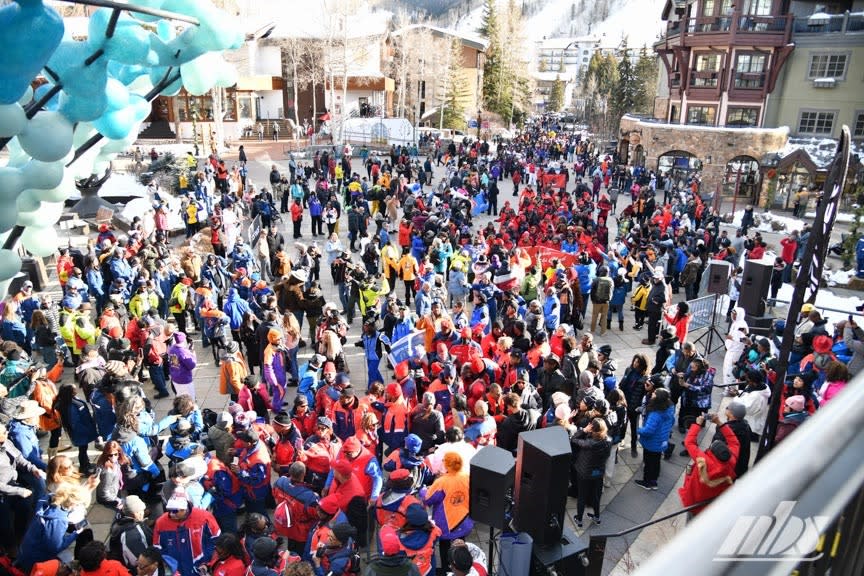Group works to increase African American participation in winter sports
OTSEGO TOWNSHIP, Mich. (WOOD) — If you ski or snowboard, you’ve probably noticed African Americans are few and far between on the slopes, but that doesn’t mean they’re not out there.
“We often get asked why are you here? Our response is just to look up the hill and go, we’re here for the snow just like everybody else,” said Ollie Barnes, who has been skiing since 1990.
“I finished my doctoral degree, and one of my advisors said well, if you want to stay around Michigan, why don’t you learn to do something with the snow? And he said why don’t you learn skiing?”
Barnes and his wife put on every bit of clothing they owned and hit the slopes at Bittersweet Ski Resort. One year later, he founded the Diamond Ice Ski Club. For the past 25 years, Barnes has been building a community with other Black skiers and working hard to dispel a lot of myths.
“A lot of folks believe that African Americans don’t want to be outside because it’s cold and that’s just not true. We’re standing outside now, we have on the right equipment, but we’re not cold,” Barnes said, adding, “It’s also the fear. Most folks will say to us I’m afraid I’m going to break my leg. The equipment is so phenomenal now that people aren’t breaking legs.”
Diamond Ice is one of approximately 60 clubs across the U.S. that fall under the umbrella of the National Brotherhood of Snowsports, or NBS. Henri Rivers is the president. Growing up in the Catskill Mountains of New York, he had two options.
“Back in the ’60s, come Thanksgiving, we got 3 feet of snow on the ground. you either locked yourself up in the house from November to March or you went out and you enjoyed the outdoors. I was not getting locked up in the house.”
Skiing has historically been an activity reserved for people of a certain class, but as the only Black kid in a town of approximately 125 people, Rivers was already used to being the minority.
“I wasn’t smart enough to catch on at that age. I just figured, you know, it was something to do, I’m going to do it, and I just stuck with it. I skied there every day, every winter, as I got older, and eventually, I got good enough to make the high school ski team. I think making the team changed my perspective on the sport because probably if I hadn’t made the team I probably would not have continued skiing.”
Rivers has been skiing for more than 50 years, but it was decades before he skied with other people of color.
“I went on the first NBS event in 1996. I witnessed over 300, 400 people of color, Blacks, all skiing and having a great time and it just changed my whole perspective of the sport,” Rivers recalled. “I had never seen anyone else of color skiing, so when I got to ski with them, it was like heaven.”
NBS has been hosting annual summits since 1973 to provide financial support to the nonprofit Olympic Scholarship Fund. The mission is to “identify, develop and support athletes of color who will win Olympic and International winter sports competitions, representing the United States, and to increase participation in winter sports.” The summit brings together all the local clubs from across the U.S. for a week of winter sports fun.

“It’s just like a family reunion every year. It’s a big party and we just can’t wait to get there,” Rivers said.
Although African Americans are a small portion of the overall skiing population, Rivers said it continues to grow.
“Yeah, there are barriers, economic barriers, but if you’re a skier, you’re an outdoors person you’re willing to spend the money. Geographically there are barriers because most of us do not live in a resort town or in the foothills of mountains, that is true, but just like anything else.. we don’t live in the Caribbean, but we get there,” Rivers explained.
Another barrier is not knowing where to start. NBS takes care of that.
“If you go out, you drop 200 dollars for a lift ticket, you drop 60 bucks for rentals, you drop 60 dollars for food so you’re close to 400 dollars for the day and you’re not dressed properly or you didn’t take a lesson and you’re falling all over the place, you’re not going to be happy,” Rivers said. “The club will take you in, the club will guide you, they’ll nurture you, they’ll help you learn how to be prepared to go and have a full fun day in the outdoors.”
Local clubs host their own events throughout the season, but the summit is the main national event. This year, it will take place in Big Sky, Montana, from Feb. 24 to March 2. Last year’s event raised enough money to fund scholarships for 29 different athletes from across the country to compete in a variety of disciplines.
For the latest news, weather, sports, and streaming video, head to WOODTV.com.

